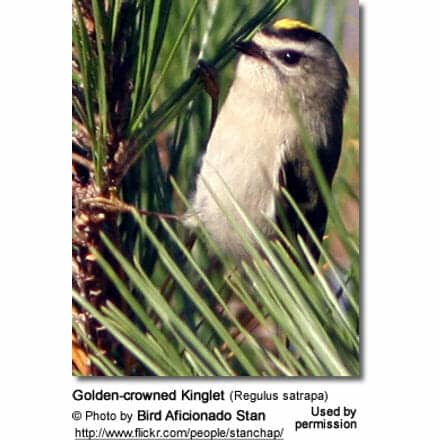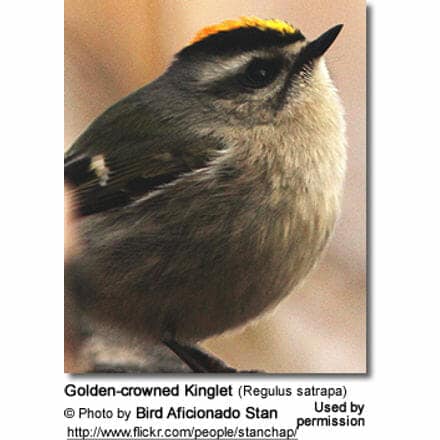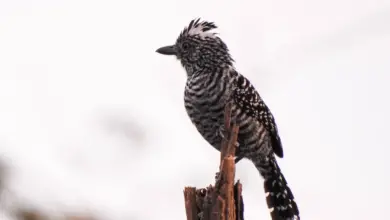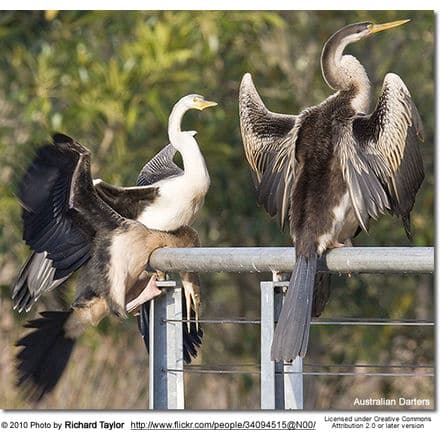Golden-crowned Kinglets
The Golden-crowned Kinglets (Regulus satrapa) is one of the two species of Kinglets found in North America. The other is the Ruby-crowned Kinglet.
It is one of the smallest songbirds being about the size of an average hummingbird.
Distribution / Habitat
Most prefer the northern conifer forests. Some will remain permanently in coastal regions and in the southern parts of their range. Birds living in the northern regions will only migrate a short distance south for the winter.
The Golden-crowned Kinglet’s territories are vast, spreading across North America and much of Canada. It uses large areas of Canada and many of the northern States as its breeding ground. In winter, it migrates through the central States to many of the southern States, from Florida to Texas and Mexico. Separate subspecies of the Golden-crowned Kinglet dwell in the remote mountain ranges of southern Mexico and Guatemala.
During migration and in winter they can be found in a wide variety of habitats, including lowland deciduous woodlands, orchards, Ponderosa pine forests, and along tree-lined streams, though they tend to prefer conifers.
Description
This tiny bird is similar in size and shape to the Ruby-crowned Kinglet but can be distinguished from the Ruby-crowned by the colors of its plumage. It has an area of black surrounding the yellow patch in the center of its crown. The male has an additional patch of orange centered within the yellow patch on the crown. This is usually hidden unless the male becomes excited.
The central patch area is bordered in black feathers. Its face is a light grey with a black stripe from the lore to the back of the head. The black beak is sharply pointed, and it has a white supercilium (eyebrow) area.
The wings are grey with white tips at the ends of the feathers. The central areas of the wings are striped with yellow and black wingbars. Its breast and belly are a light olive-grey, and its back and rump are olive green. The short, wide tail is also grey with white shading along the edges of the feathers.
The juvenile’s appearance is similar to the adult’s, but its back is more of a brown shade and its crown is not yellow.
Diet / Feeding
Golden-crowned Kinglets are quite visible during the winter months; they gather with other small birds and create a flock fairly easy to see. Sometimes they form quite sizeable groups. This diminutive bird is constantly moving, flicking its wings as it forages for insects in shrubs, trees and ground cover.
These Kinglets will forage high up in the canopy of conifers, hovering near branches or clinging to twigs to locate its favorite foods—insect eggs and spiders—which have stuck to the undersides of leaves and twigs. They also dart out to catch tiny, flying insects on the wing.
Their flight is quick and fluttery, and they frequently flick their wings. In winter and on migration, they often forage much closer to the ground. They will also feed on a few types of available seeds and fruits when necessary.
Breeding / Nesting
The Golden-crowned Kinglets chooses the coniferous forests across Canada, the northeastern and western United States, Mexico and Central America to establish their nesting sites. They prefer the dense fir and spruce forests which have closed canopies and are in isolated locations. Their well-hidden nests are constructed in spherically shaped, hanging cups which they suspend from the conifer tree branches.
This species of Kinglet is monogamous within the breeding season, but will form new pair bonds during the next breeding season. Since their nests are located very high in the conifer trees—as much as 50 feet or more from the ground—they are very difficult to find. Both the male and female construct the nest, suspending it close to the tree trunk between two horizontal twigs; the branches hanging above the nest shelter and protect it from predators and the elements.
The nest is composed of moss, lichen, bark strips, twigs, and spider webs. The inside of the nest is layered and quite deep with a lining of feathers, plant down, rootlets, and hair to create a soft inside layer for the chicks.
As many as 11 eggs may be laid, but generally it is 8 or 9. During the two weeks the females are incubating the eggs for about 11-14 days, the males assist by bringing food to her. After the chicks hatch, she will brood them for 3 to 5 days. She and the male both feed the young.
The chicks fledge 14 to 19 days after hatching and leave the nest. While the male continues to feed the first brood for another two weeks, the female prepares to start a second clutch.
Calls / Vocalizations
The visitor will be able to hear their series of high-pitched calls, produced on a single note, as the birds are not too fearful of humans in their territory.







